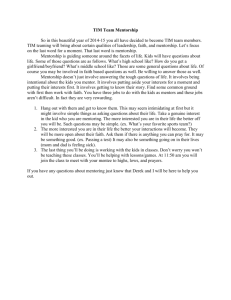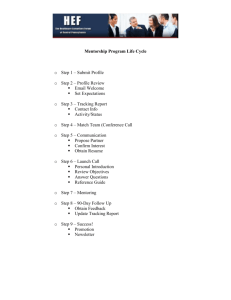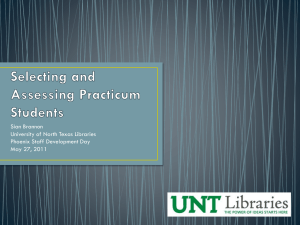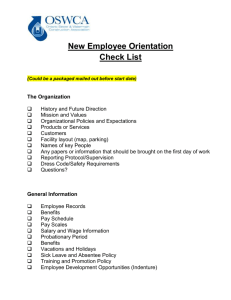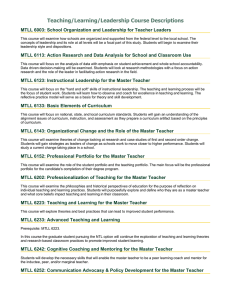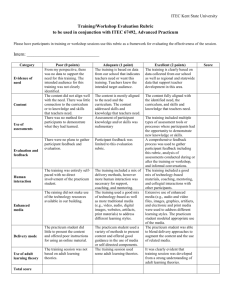Document 10465763
advertisement
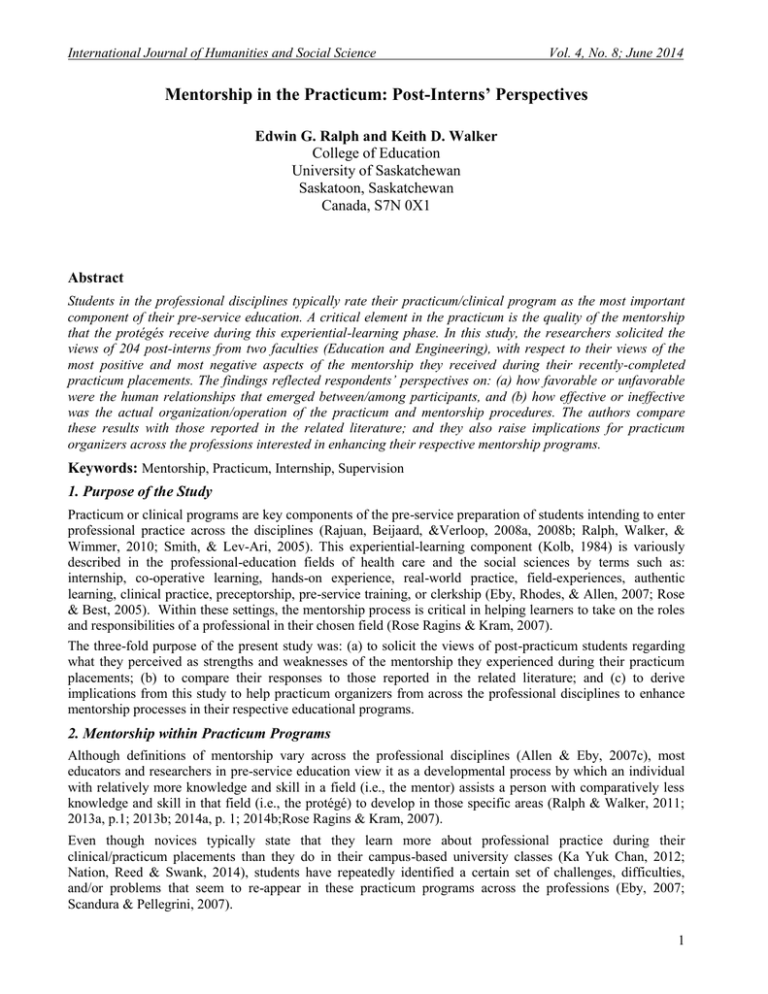
International Journal of Humanities and Social Science Vol. 4, No. 8; June 2014 Mentorship in the Practicum: Post-Interns’ Perspectives Edwin G. Ralph and Keith D. Walker College of Education University of Saskatchewan Saskatoon, Saskatchewan Canada, S7N 0X1 Abstract Students in the professional disciplines typically rate their practicum/clinical program as the most important component of their pre-service education. A critical element in the practicum is the quality of the mentorship that the protégés receive during this experiential-learning phase. In this study, the researchers solicited the views of 204 post-interns from two faculties (Education and Engineering), with respect to their views of the most positive and most negative aspects of the mentorship they received during their recently-completed practicum placements. The findings reflected respondents’ perspectives on: (a) how favorable or unfavorable were the human relationships that emerged between/among participants, and (b) how effective or ineffective was the actual organization/operation of the practicum and mentorship procedures. The authors compare these results with those reported in the related literature; and they also raise implications for practicum organizers across the professions interested in enhancing their respective mentorship programs. Keywords: Mentorship, Practicum, Internship, Supervision 1. Purpose of the Study Practicum or clinical programs are key components of the pre-service preparation of students intending to enter professional practice across the disciplines (Rajuan, Beijaard, &Verloop, 2008a, 2008b; Ralph, Walker, & Wimmer, 2010; Smith, & Lev-Ari, 2005). This experiential-learning component (Kolb, 1984) is variously described in the professional-education fields of health care and the social sciences by terms such as: internship, co-operative learning, hands-on experience, real-world practice, field-experiences, authentic learning, clinical practice, preceptorship, pre-service training, or clerkship (Eby, Rhodes, & Allen, 2007; Rose & Best, 2005). Within these settings, the mentorship process is critical in helping learners to take on the roles and responsibilities of a professional in their chosen field (Rose Ragins & Kram, 2007). The three-fold purpose of the present study was: (a) to solicit the views of post-practicum students regarding what they perceived as strengths and weaknesses of the mentorship they experienced during their practicum placements; (b) to compare their responses to those reported in the related literature; and (c) to derive implications from this study to help practicum organizers from across the professional disciplines to enhance mentorship processes in their respective educational programs. 2. Mentorship within Practicum Programs Although definitions of mentorship vary across the professional disciplines (Allen & Eby, 2007c), most educators and researchers in pre-service education view it as a developmental process by which an individual with relatively more knowledge and skill in a field (i.e., the mentor) assists a person with comparatively less knowledge and skill in that field (i.e., the protégé) to develop in those specific areas (Ralph & Walker, 2011; 2013a, p.1; 2013b; 2014a, p. 1; 2014b;Rose Ragins & Kram, 2007). Even though novices typically state that they learn more about professional practice during their clinical/practicum placements than they do in their campus-based university classes (Ka Yuk Chan, 2012; Nation, Reed & Swank, 2014), students have repeatedly identified a certain set of challenges, difficulties, and/or problems that seem to re-appear in these practicum programs across the professions (Eby, 2007; Scandura & Pellegrini, 2007). 1 © Center for Promoting Ideas, USA www.ijhssnet.com It seems prudent that practicum leaders should not only heed the student voice (Booth, 1993; Mohamad Diah, Rahman, Mustari, & SyafikaRamli, 2014)both by continuing to maintain the positive features and by seeking to remove the limitations that were identified (O'Donovan, Halford, & Walters, 2011; Ralph, Walker, & Wimmer, 2007). 2.1. Benefits of Mentorship in the Practicum Despite the varied terms used to identify mentoring processes in practicum/clinical education programs across the professions (Allen & Eby, 2007b; Ralph & Walker, 2011; Rose & Best, 2005), protégés regularly rank the guidance provided by their mentors’ as crucial to their professionalization (Allen & Eby, 2007a; Koberg, Boss, & Goodman, 1998; Ulvik& Smith, 2011). A sampling of the cross-disciplinary literature from several countries (Barlish & Taylor, 2014; Johansson-Fua, Ruru, Sanga, Walker, & Ralph, 2012; Johansson-Fua, Sanga, Walker, & Ralph, 2011; Martin, Siosteen, &Shephard, 1999; Rose, 2005; Ruru, Sanga, Walker, & Ralph, 2013) showed that students repeatedly identified several benefits they derived from working in mentoring relationships characterized by trust and approachability. These positive aspects became evident when the mentors in these relationships were skilled at assisting their protégés to: Consider the mentoring feedback they received (both positive and negative) as a learning opportunity to grow professionally and personally acquire the requisite body of knowledge, skills, and procedures for entering the profession develop in their overall technical and professional competence and confidence learn to not only perform the essential routines, techniques, and strategies of practice, but also not to fear dealing with unexpected, unforeseen, and unpleasant situations that inevitably arise in the workplace begin to understand and navigate the broader environment of the institution, organization, and profession internalize the unique dispositions/attitudes/values espoused by the profession engage in professional networking and to participate in learning communities understand how to advance in their personal career trajectory Other reported benefits were that mentors developed professionally and personally, and the host unit tended to witness revitalized staff commitment, communication, productivity, and administrative practice. An effective mentorship program also helped promote the achievement of the department’s core vision and mission; and it facilitated the overall growth and credibility of the larger organization—which in turn may contribute to the welfare of society as a whole (Ralph, Walker, & Wimmer, 2010; Rose & Best, 2005). 2.2 Limitations of Mentorship in the Practicum Over the past three decades the relevant literature has affirmed the advantages of mentorship for protégés in practicum/clinical programs (Anderson, Walker, & Ralph, 2009; Darwin & Palmer, 2009); however, it has also identified certain limitations that seem to linger or re-emerge during this mentorship process (Benson, 2013; Eby, 2007; Lugton, 2000; Ralph, Walker, & Wimmer, 2009a; Zeichner, 2010). Upon reviewing this body of research (Abbott Demish, 2005; Chen, Hu, Wang, & Chen, 2011; Falender, Ellis, & Burnes, 2013; Killam & Heerschap, 2013; Rose & Best, 2005; Starkey & Rawlins, 2011; Zopiatis, 2007), the present authors have identified ten lingering weaknesses that seem to re-appear within mentorship practice, across the disciplines and across cultures. 1. Mentorship problems are more prevalent in program settings that are disorganized, poorly structured, and/or ill-managed; and where miscommunication, misinterpretation, and misjudgment are frequent. In such situations, trust and collaboration are lacking, and camaraderie is scarce. 2. When interpersonal conflicts arise, participants often resort to denying, blaming, rationalizing, and/or projecting, which in turn lead to increased anxiety, anger, resentment, and/or intransigence between mentorship partners. 3. Often, mentors attribute the difficulty to protégés, because of the pre-assumption that the mentor not only possesses advanced knowledge but exercises a power differential over the protégé. 4. Mentorship difficulties also tend to arise if the mentor is forced into the mentorship role; is too busy to appropriately fulfill the mentoring obligation; has little or no mentorship preparation, education, training, or orientation; or is not adequately supported by senior administration or the larger organization. 5. The institution’s poor mentorship placement procedures for assigning protégés, and its lack of proper recruitment of mentors can further exacerbate relationship problems. 2 International Journal of Humanities and Social Science Vol. 4, No. 8; June 2014 6. If mentors receive no incentives/benefits that they find meaningful and valuable for their mentoring service, then their motivation to be involved will further decline. 7. When protégés witness the above negative events, conditions, and situations, their own motivation to participate will also tend to be hindered. 8. Relationship problems are compounded if the mentor relies on a single mentoring or leadership style, rather than being prepared to continually adapt the degree of mentoring direction and support he/she provides the protégé. This adaptive mentorship response must match the protégé’s changing developmental level. 9. With respect to mentorship in cross-cultural settings, if the afore-mentioned adaptive-mentorship process does not take into consideration specific cultural idiosyncrasies, ethnic differences, and inter-cultural customs, then mentoring relationships will tend to suffer. 10. These types of difficulties tend to emerge when a practicum program lacks a clear mentorship model or conceptual framework to guide participants in the mentorship process. The logical response in addressing these limitations is first to recognize them and then to work at remedying or at least reducing them (Hobson, & Malderez, 2013; Rose & Best, 2005; Ryan, 2005). 3. Method In order to examine post-interns’ perceptions of the quality of the mentorship they received in their recentlycompleted practicum programs, the authors invited several of them to complete a brief printed survey. These post-interns had returned to the university to complete remaining courses in their pre-service programs, and at that time the authors solicited their views regarding two aspects of their practicum mentorship-experiences. 3.1. Respondents The 204 respondents were representative of the population of post-interns, who accepted our invitation over a four-year period from 2009 to 2013 to anonymously and confidentially submit written responses to a brief twoitem survey regarding their internship experience. There were 192 volunteers from the College of Education and 12 respondents from the College of Engineering at a Western Canadian university. On the surveys, the students were requested not to identify themselves, their major/minor program, nor their age or sex. However, they had all been within one or two years of completing their respective Bachelor degree programs. A key difference between the Education and Engineering sub-groups, in addition to group size, was that the Education students completed the compulsory, non-salaried 16-week extended-practicum in a school setting, which counted as a 12-credit university course and for which they had to pay tuition fees. By contrast, the Engineering internships were optional and salaried over a 3- to 12-month period, and were not part of the students’ Bachelor program. Participating in the optional internship necessitated the Engineering students putting their education program “on hold” during that period of employment with an engineering firm. 3.2 Survey Instrument The printed survey consisted of two questions: “What was the most positive aspect of your mentorship experience during the internship?” and “What was the most negative aspect of your mentorship experience during the internship?” 3.4. Data Analysis The authors used a mixed methods research design for the study (Creswell, 2015) and they applied the constant comparative technique (Leedy & Ellis Ormrod, 2013) to analyze and categorize each of the 612 comments provided by the 204 post-interns. In the data analysis the authors sought for patterns and categories (Gay, Mills, & Airasian, 2012) that became apparent within the data, after which they calculated percentages of postinterns’ views that coincided with these emerging themes, and then they recorded these values. 4. Results These data synthesized in Table 1 show the positive and negative aspects reported by the post-interns with respect to their mentorship experiences during their practicum placements. Overall, the post-interns provided a greater number of positive items than they did negative ones; and in the following sub-sections the authors elaborate on each category by presenting some of the respondents’ quotes regarding the themes. 3 © Center for Promoting Ideas, USA www.ijhssnet.com Table 1: Post-interns’ Perceptions of the Quality of the Mentorship Experience 1. 2. 3. 4. 5. 6. 7. 8. 1. 2. 3. 4. 5. Category Favorable Features (from 371 comments) Had positive relationship with mentor Opportunity for real-world experience Felt part of the team/community Developed personal confidence Contributed to welfare of clients/students Had positive relationship with university supervisor Established contacts for future employment Gathered resources/materials for later employment Limiting Factors (from 241 comments) University program deficiencies Unfavorable relationship with mentor Financial or travel difficulties Unpleasant relationships with team/staff Strained relationship with university supervisor Percentage 30 23 23 8 7 5 2 1 39 36 10 8 7 Note. Respondents (N=204) wrote a total of 612 distinct comments on their surveys. Values are the percentages of those comments in each category. Values in the upper portion do not add up to 100 because of rounding. 4.1 Positive Aspects Approximately 61% of the post-interns’ written contributions identified positive features of the mentorship process they experienced. The largest positive sub-category consisted of statements dealing with the productive and constructive relationship that the protégé and mentor forged with one another during the practicum. Typical comments illustrating this theme were: “My mentor gave me both positive feedback and suggestions as to improve myself and how to manage them in the classroom;” “It was the warm welcoming staff, but especially my mentor-teacher who made my experience awesome!” and “She helped me learn how to effectively communicate ideas with another professional, and to receive and reflect upon her feedback, plus I could build on the professional networks I made before I had to enter the workforce.” The next two similarly-sized categories each consisted of nearly one-quarter of the positive statements. The first category of this pair was related to post-interns’ appreciation for the opportunity to engage in practical learning in authentic settings, in which they were supported as they sought to develop their professional knowledge and skills. Sample responses characterizing this category were: “I liked finding out what I was both good and bad at in a real-world setting, rather than guessing and hypothesizing in university self-reflection assignments in classes;” “The best was learning about the practical realities of classroom teachers, having direct feedback about my teaching, and building relationships with colleagues, as opposed to the theory in university classes;” and “I actually gained practical knowledge and experience regarding the operation of a classroom and a school—I was able to put theory to practice and get guidance with my practice.” The other category of the pair identified post-interns’ commendations of the work-group or staff for welcoming them as valued members of the team/community. Typical statements exemplifying this sentiment were: “They staff all recognized me for my contributions to teaching and for being part of the [music] rehearsal activities, even though I was just new to their rehearsals;” “The most valuable was the knowledge I gained from working with senior staff members and tradespeople [in engineering]. I got to discuss various projects as a teammember and got their opinions, which was very beneficial in developing my critical thinking skills;” and “I got to actually work with the school and I was treated just like one of the staff-members. I was also able to teach with the principal who was amazing.” The fourth sub-category regarding productive mentorship consisted of affirmations by respondents that they were enabled to build their professional and personal confidence. These comments were more related to the psycho/social/emotional realm of learning than to the technical and competency aspect. 4 International Journal of Humanities and Social Science Vol. 4, No. 8; June 2014 Submissions that illustrated this topic were: “It was positive to gain confidence in my skills as a professional and to feel affirmed in my choice of teaching as a career;” “Because I got to work in a rural school with kids of all ages, K to 12, I felt like I became a valuable member of that community;” and “My mentor was very willing to let me try new things, so I soon felt like I wasn’t ‘stepping on toes.’ I grew completely comfortable in doing my own thing, but still took her constructive feedback based on her experiences.” The fifth sub-category consisting of six percent of the positive statements, was focused on the benefit articulated by post-interns related to being able to help their clients/students reach their goals. Responses reflecting this theme were: “I was given an extremely high level of responsibility for an intern, but I was very happy with it because it helped me understand the multiple aspects of engineering services;” “I enjoyed the relationships I developed with the students that furthered their education;” and “Number one for me of course was working with children and watching them ‘have those light bulbs go on’.” Five percent of the comments (which were submitted by the Education post-interns, because of the nature of their compulsory internship program) referred to the positive relationship that developed with their universitybased internship facilitator/supervisor. Sample statements here were: “The college supervisor was supportive and an excellent resource;” “The positive and knowledgeable support of my university supervisor was invaluable. It was important that he was directly involved with the university;” and “She was very genuine and helped me through a lot of difficult situations. She was not judgmental but she worked hard at trying to help me as much as she could.” A seventh theme that emerged from the submissions of the Engineering post-interns reflected the value of being able to use the internship experience to make contacts with future employers. The following comment illustrated this position: The most positive aspect was the job offer I received upon the completion of my degree. My internship with [the company] enabled me to make contacts with that firm and others in the industry that I would be working in. I learned a lot about the company and gained valuable knowledge from experienced colleagues in my field…Internship programs provide both the students and the employers with information about the knowledge of the students and the expectations of the employers. This interaction provides a way for the Engineering field to adjust our educational programs to meet the needs of the industries in our country. The final positive category, and the smallest, described post-interns’ appreciation for being able to gather resource materials and ideas from their mentors, which they could use in later employment. Responses exemplifying this theme were: “By the end, I was able to add a lot to my professional portfolio and to my resource pile;” “It was valuable to have support through ideas, encouragement, and materials. It was great to know that someone there had your back;” and “I got to take away lots of resources they had, which I could use in my own teaching.” In summary, one observes that the positive findings shown in upper portion of Table 1 generally confirm previous results reported in the related literature cited earlier in this paper, regarding the advantages of effective mentorship in professional education. It is noteworthy that a key word in this statement is “effective,” because when the mentorship was effective, then the benefits accrued to all participants—protégés, mentors, clients/students, the practicum programmers, and the organization as a whole (Allen & Eby, 2007c; Ralph, Walker, &Wimmer, 2010). By contrast, when deficiencies existed within the mentorship process, the results were not as favorable, as demonstrated in the following sub-section. 4.2 Negative Aspects On their written surveys, nearly all respondents indicated one or more areas of deficiency in the mentorship process of their practicum, with the exception of 12 of the 204 post-interns, who either wrote “n/a,” “none,” or left the space blank after the second question. The negative aspects that were reported in this study are summarized in the lower portion of Table 1. The largest category consisted of respondents’ submissions regarding weaknesses within the organization or administration of practicum program, which in turn had varying effects on the mentorship process. Postinterns’ comments that illustrated this first theme were: “My mentor and I felt there was a lack of communication between the college and us in regards to new policies and expectations and new changes;” 5 © Center for Promoting Ideas, USA www.ijhssnet.com “The interns had a negative attitude toward the internship seminars, and many of the tasks we were required to do didn’t help our actual internship;” and “I felt that the college’s approach to have us waste valuable time filling out busy-work records was useless.” The second largest negative theme, consisting of more than a third of all the unproductive aspects identified by respondents, were focused on unfavorable or negative relationships within the mentoring process. Remarks describing such situations were: “. “I found it difficult to be professional when working with my mentor who had a one-track way of thinking. She was not aware of the mentoring process, nor was she willing to learn it;” “There was a lack of communication and rapport with my mentor; I believe mentors need more training in working with interns;” “There was little or no mentorship in my company. My mentor was just too busy to provide guidance for me, and was actually dismissive;” and “My mentor seemed incapable of sharing her space and teaching responsibilities, and was unable to work with an intern, which all made my experience extremely negative.” A third theme that characterized 10 percent of the unfavorable comments referred to the difficulty for interns arising from financial burdens related to the internship. This problem particularly affected the Education interns who had been placed in rural schools for the four-month practicum. Typical comments here were: “It was very costly having to pay for two residences and my bills. It was over the top, because interns are not paid for our internship work nor are we given financial help;” “The most negative thing was paying the ridiculous amount for tuition on top of rent and expenses in two places!! This is a serious glitch in the system that needs to be examined;” and “Having to pay $2500 tuition, plus rent in another town, plus work hard (for no money) for four months. Unacceptable.” Interestingly, an Engineering post-intern’s remark regarding this financial aspect identified a reverse problem: “I was pleased to learn while earning a salary, but the problem was I didn’t manage to save any money.” The fourth largest difficulty was the existence of unpleasant relationships between the protégé and other staffmembers. Comments typifying this sub-category were: “The atmosphere among the school staff was not good; some things were going on behind the scenes that were unknown to me;” “I found out one teacher commented on my professional behavior behind my back, instead of coming to me personally as a member of the profession and treating me like a teacher; “I was made to feel inferior to other staff. My ideas were regarded as being naïve and openly rejected, simply because I was an intern. (But I later found out my suggestions were implemented);”and My firm had a plethora of problems ranging from general disorganization to a complete lack of mentorship training at all levels. Much more would have been learned if there had been an “internship program” with specific learning goals within the company. A weakness identified in the final category was similarly related to disagreeable relationships, but this difficulty was identified as existing between the protégé and the university internship supervisor. Similar to the earlier supervisory case described in the upper portion of Table 1, this theme related only to Education respondents, because the Engineering interns were not mentored by university-based supervisors. Illustrative comments reflecting this negative factor among Education contributors were: “The negative part was my college supervisor. Because of my unique situation I was left with little or no guidance for two months. He offered no extra support, no extra visits, or no calls!” “The internship seminars with the college supervisor were unhelpful. The sessions could have been better spent clarifying expectations and our evaluation, rather than merely sharing stories. On visits, the supervisor did not suggest areas to improve, but only said, ‘Good job’;” and “The brief ‘in and out’ evaluation visits by my supervisor were poor. He spent very little time with me, but still made sure to evaluate me! This system is a waste of time and money. Seriously, how much are you paying him, because my tuition was $5000?” Although the negative comments accounted for only 39% of the total submitted statements, they described aspects that appeared poignantly significant and emotional for the post-interns in this study. 6 International Journal of Humanities and Social Science Vol. 4, No. 8; June 2014 5. Implications for Practicum-Mentorship Administrators The results of this study were not inconsistent with previous similar research documenting the importance of the student voice regarding practicum quality (Booth, 1993; Chen, Hu, Wang, & Chen, 2011; Cook-Sather, 2002; Delaram, 2012; Mohamad Diah, Rahman, Mustari, & SyafikaRamli, 2014; Ralph, Walker, & Wimmer, 2008a, 2008b, 2009b, 2009c; Ronfeldt &Reininger, 2012; Ryan, 2005). Moreover, the nearly two-to-one ratio of favorable to unfavorable comments summarized in this present study corroborated previous findings reported in the literature. This trend generally substantiated the overall worth of practicum mentorship to enhance participant learning, but it also identified chronic challenges that seem to persistently arise and that need to be resolved (Dale Fitzgerald, 2009; Hatcher, 2014; Johnson & Kaslow, 2014; Killam & Heerschap, 2013; Kost, 2008; Luparell, 2011; Ralph, Walker, & Wimmer, 2007; 2009a; 2010). A logical consequence emerging from all these results is that the organizers of the mentorship programs in this study, as well as others who may read this report, will not only want to maintain and to celebrate the strengths of the programs that exist, but they will no doubt want to eliminate the barriers that are unproductive. For instance, to help de-fuse mentoring disagreements in a dyad before they escalate, program leaders should ensure that all mentorship stakeholders understand the procedures and protocols for dealing with conflicts that may arise in the mentoring relationship. An example of such pre-emptive action is Ryan’s (2005, pp. 172-173) suggested scale of graduated strategies: (a) to have the mentor/protégé pair work at resolving the particular issue, collaboratively; (b) to encourage them to seek outside advice, sooner than later; (c) to introduce a third party who could mentor the original pair, as needed; (d) to terminate the mentorship relationship, if necessary; and/or (e) to reassign the protégé to a new placement (and to decide whether or not to divulge the initial withdrawal experience to the subsequent mentor). In the light of all these findings regarding the integral role that mentorship occupies in the professional development of prospective practitioners, the present authors endorse the assertions of O’Brien, Moore, Dawson, & Hartley (2014) and Zeichner (2010), which assert that practicum administrators should not only attend to recruiting and preparing effective mentors from both inside and outside of the academy, but they should do so by beginning this critical process of “mentoring the mentors” even before the novices progress too far in their own career trajectories. Thus, practicum/clinical educators could begin to prepare current students in pre-professional education programs by inviting them to consider becoming mentors, themselves, earlier rather than later, as they progress along their respective professional career paths. In this way, organizers of professional education programs will have taken an anticipatory step ahead in helping society prepare to meet the projected shortage of mentors in the future (Butcher, 2013; Casey, 2012). References Abbott Demish, H. (2005). Counselling practicum placements: The counsellor educators’ perspectives (Master’s thesis). Athabasca University, Athabasca, Alberta, Canada. Retrieved from http://dtpr.lib.athabascau.ca/action/download.php?filename=caap/heatherdemishproject.pdf Allen, T., & Eby, L. (2007a). Common bonds: An integrative view of mentoring relationships. In T. Allen & L. Eby (Eds.), The Blackwell handbook of mentoring: A multiple perspective approach (pp. 397-419). Malden, MA: Blackwell. Allen, T., & Eby, L. (2007b). Overview and introduction. In T. Allen & L. Eby (Eds.), The Blackwell handbook of mentoring: A multiple perspective approach (pp. 3-6). Malden, MA: Blackwell. Allen, T., & Eby, L. (Eds.). (2007c). The Blackwell handbook of mentoring: A multiple perspective approach. Malden, MA: Blackwell. Anderson, K., Walker, K., & Ralph, E. (2009). Practicum teachers’ perceptions of success in relation to self-efficacy (perceived competence). The Alberta Journal of Educational Research, 55(2), 157-170. Retrieved from http://ajer.journalhosting.ucalgary.ca/ajer/index.php/ajer/article/viewFile/724/696 Barlish, K., & Traylor, C. (2014). Career paths and development: Actions and examples from the heavy civil sector. Practice Periodical on Structural Design and Construction, 19, 2-7. doi: 10.1061/(ASCE)SC.1943-5576.0000185 Retrieved from http://ascelibrary.org/doi/full/10.1061/%28ASCE%29SC.1943-5576.0000185 7 © Center for Promoting Ideas, USA www.ijhssnet.com Benson, J. (2013, May). Evaluation of a clinical practicum evaluation tool to address the education to practice gap in nursing. A scholarly project submitted to the Kent State University Graduate College of Nursing, in partial fulfillment of the requirements for the degree of Doctor of Nursing Practice. Kent, OH. Retrieved from https://etd.ohiolink.edu/rws_etd/document/get/kent1368114147/inline Booth, M. (1993, June). The effectiveness and role of the mentor in school: The students' view. Cambridge Journal of Education, 23 (2), 185-197. Retrieved from http://web.b.ebscohost.com/ehost/detail?sid=ec2f842c-7b9d-4b97-acd6ac2aa6b91dce%40sessionmgr113&vid=1&hid=127&bdata=JnNpdGU9ZWhvc3QtbGl2ZQ%3d%3d#db=pb h&AN=9603085594 Butcher, D. (2013, November 11). How to be an effective mentor. ThomasNet News [sic], Industry Market Trends. Retrieved from http://news.thomasnet.com/IMT/2013/11/11/why-and-how-to-be-an-effective-mentor/ Casey,B. (2012,April). STEM education: Preparing for the jobs of the future. A Report by the Joint Economic Committee Chairman’s Staff. Retrieved from http://www.jec.senate.gov/public/index.cfm?a=Files.Serve&File_id=6aaa7e1f-9586-47be-82e7326f47658320 Chen, C.T., Hu, J., Wang, C., & Chen, C.F. (2011) A study of the effects of internship experiences on the behavioural intentions of college students majoring in leisure management in Taiwan. Journal of Hospitality, Leisure, Sport and Tourism Education, 10(2), 61-73. Retrieved from http://www.heacademy.ac.uk/assets/hlst/documents/johlste/vol10no2/AP5294ChenEtAl61to73.pdf Cook-Sather, A. (2002, May). Authorizing students' perspectives: Toward trust, dialogue, and change in education. Educational Researcher, 31(4), 3–14. doi: 10.3102/0013189X031004003 Retrieved from http://edr.sagepub.com/content/31/4/3 Creswell, J. (2015). A concise introduction to mixed methods research. Thousand Oaks, CA: Sage. Dale Fitzgerald, M. (2009, October). Reflections on student perceptions of supervisory needs in clinical education. American Speech-Language-Hearing Association SIG 11 Perspectives on Administration and Supervision, 19, 96-106. doi:10.1044/aas19.3.96. Abstract retrieved from http://sig11perspectives.pubs.asha.org/article.aspx?articleid=1766041 Darwin, A. & Palmer, E. (2009, April). Mentoring circles in higher education. Higher Education Research & Development, 28(2), 125–136. Retrieved from http://athleticmentoring.com/wp-content/uploads/2010/08/Mentoring-Circles-in-Higher-Education-Study.pdf Delaram, M. (2012). Strengths and weaknesses of clinical education from the viewpoints of nursing and midwifery students in Shahrekord University of Medical Sciences, Shahrekord, Iran. QOM University of Medical Sciences Journal, Home, 6(2). Retrieved from http://journal.muq.ac.ir/en/index.php/jmuqen/article/view/239 Eby, L. (2007). Understanding relational problems in mentoring. In B. Rose Ragins & K. Kram (Eds.), The handbook of mentoring at work: Theory, research, and practice (pp. 323-344). Los Angeles, CA: Sage. Eby, L., Rhodes, J., & Allen, T. (2007). Definition and evolution of mentoring. In T. Allen & L. Eby (Eds.), The Blackwell handbook of mentoring: A multiple perspective approach (pp. 7-20). Malden, MA: Blackwell. Falender, C., Ellis, M., & Burnes T. (2013, January). Response to reactions to major contribution, multicultural clinical supervision and benchmarks. The Counseling Psychologist, 41(1), 140-151. doi: 10.1177/0011000012464061 Retrieved from http://tcp.sagepub.com/content/41/1/140.full Gay, L., Mills, G., & Airasian, P. (2012). Educational research: Competencies for analysis and applications (10thed.). Toronto, ON: Pearson. Hatcher, R. (2014). The new prominence of practicum training in professional psychology: A guide for practicum supervisors and trainers. Washington, DC: National Register of Health Service Psychologists. Retrieved from http://e-psychologist.org/index.iml?mdl=exam/show_article.mdl&Material_ID=67 Hobson, A., & Malderez, A. (2013). Judgementoring [sic] and other threats to realizing the potential of school-based mentoring in teacher education. International Journal of Mentoring and Coaching in Education, 2 (2). 89108. Retrieved from http://shura.shu.ac.uk/7224/1/Hobson_and_Malderez_2013_Judgementoring_IJMCE_Post-print_draft.pdf Johansson-Fua, S., Ruru, D., Sanga, K., Walker, K., & Ralph, E. (2012). Creating mentorship metaphors: Pacific Island perspectives. Learning Landscapes, 6(1), 243-261. Available from http://repository.usp.ac.fj/5579/1/Creating_Mentorship_Metaphors_Pacific_Island_Perspectives.pdf Johansson-Fua, S., Sanga K., Walker, K., & Ralph, E. (2011). Mentorship in the professions: A perspective from Tonga. The International Journal of Mentoring and Coaching, 9(2), 19-37. Available from http://www.learninglandscapes.ca/images/documents/ll-no11.pdf 8 International Journal of Humanities and Social Science Vol. 4, No. 8; June 2014 Johnson, W., & Kaslow, N. (Eds.). (2014). The Oxford handbook of education and training in professional psychology. New York: Oxford University Press. Ka Yuk Chan, C. (2012). Assessment for community service types of experiential learning in the engineering discipline. European Journal of Engineering Education, 37(1), 29-38. doi: 10.1080/03043797.2011.644763 Retrieved from http://www.tandfonline.com/doi/pdf/10.1080/03043797.2011.644763 Killam, L., & Heerschap, C. (2013, June). Challenges to student learning in the clinical setting: A qualitative descriptive study. Nurse Education Today, 33(6), 684–691. Retrieved from http://www.sciencedirect.com/science/article/pii/S0260691712003607 Koberg, C., Boss, R., & Goodman, E. (1998). Factors and outcomes associated with mentoring among health-care professionals. Journal of Vocational Behavior, 53, 58-72. Retrieved from http://ac.els-cdn.com/S0001879197916079/1-s2.0-S0001879197916079-main.pdf?_tid=e28e92b8-ef6911e3-ab4c-00000aacb35d&acdnat=1402272560_97466345f7cf2691d127b580f2ee619d Kolb, D. (1984). Experiential learning: Experience as the source of learning and development. Englewood Cliffs, NJ: Prentice Hall. Retrieved from http://academic.regis.edu/ed205/Kolb.pdf Kost, C. (2008, Spring). Innovations in teaching assistant development: An apprenticeship model. Foreign Language Annals, 41(), 29-46. Retrieved from http://search.proquest.com/eric/docview/216006485/fulltextPDF/A1B88FF7799B4E3APQ/2?accountid=14739 Leedy, P., & Ellis Ormrod, J. (2013). Practical research: Planning and design (10thed.). Toronto, ON: Pearson. Lugton, M. (2000, Fall). Problematizing the practicum. Retrieved from http://people.umass.edu/educ870/teacher_education/Lugton-presrv.htm Luparell, S. (2011). Incivility in nursing: The connection between academia and clinical settings. Critical Care Nurse, 31, 92-95. doi: 10.4037/ccn201117 Retrieved from http://ccn.aacnjournals.org/content/31/2/92.full.pdf+html Martin, C., Siosteen, A., & Shephard, K. (1999). The professional development of expert physical therapists in four areas of clinical practice. In G. Jensen, J. Gwyer, L. Hack, & K. Shephard (Eds.), Expertise in physical therapist practice (pp. 231-244). Boston, MA: Butterworth-Heinemann. Mohamad Diah, N., Rahman, K., Mustari, S., & SyafikaRamli, N. (2014). Internship in sociology: A new dimension of increasing students’ employability in the Malaysian job market. World Applied Sciences Journal, 30(Innovation Challenges in Multi-disciplinary Research & Practice), 263-268. doi: 10.5829/idosi.wasj.2014.30.icmrp.34 Retrieved from http://idosi.org/wasj/wasj30(icmrp)14/34.pdf Nation, D., Reed, L., & Swank, A. (2014). Innovations and future directions for experiential learning for a large online business degree program. Developments in Business Simulation and Experiential Learning, 41, 312320.Retrieved from https://journals.tdl.org/absel/index.php/absel/article/view/2133 O'Brien, K., Moore, A., Dawson, D. A., & Hartley, P. R. (2014). An Australian story: Paramedic education and practice in transition. Australasian Journal of Paramedicine, 11(3), 1-13. Retrieved from http://ro.ecu.edu.au/cgi/viewcontent.cgi?article=1432&context=jephc O'Donovan, A., Halford, W.,& Walters, B. (2011, June 15). Towards best practice supervision of clinical psychology trainees.Australian Psychologist, 46(2), 101–112. doi: 10.1111/j.1742-9544.2011.00033.x Retrieved from http://onlinelibrary.wiley.com/doi/10.1111/j.1742-9544.2011.00033.x/full Rajuan, M., Beijaard, D., &Verloop, N. (2008a). Student teachers’ perceptions of their mentors as internal triggers for learning. Teaching Education, 19(4), 279-292. Retrieved from http://www.tandfonline.com/doi/pdf/10.1080/10476210802339951 Rajuan, M., Beijaard, D., &Verloop, N. (2008b). What do student teachers learn? Perceptions of learning in mentoring relationships. The New Educator, 4(2), 133-151. Retrieved from http://www.tandfonline.com/doi/pdf/10.1080/15476880802014314 Ralph, E., & Walker, K. (Eds.). (2011). Adapting mentorship across the professions: Fresh insights and perspectives Calgary, Alberta, Canada: Temeron/Detselig. Ralph, E., & Walker, K. (2013a). The efficacy of the Adaptive Mentorship model. Open Journal of Leadership, 2(2), 1-6. Available from http://www.scirp.org/journal/PaperInformation.aspx?PaperID=32622 Ralph, E., & Walker, K. (2013b). The promise of Adaptive Mentorship: What is the evidence? International Journal of Higher Education, 2(2), 76-85. Available from http://dx.doi.org/10.5430/ijhe.v2n2p76 9 © Center for Promoting Ideas, USA www.ijhssnet.com Ralph, E., & Walker, K. (2014a). Research synthesis for Adaptive Mentorship©.Contemporary Issues in Education Research. In press. Ralph, E., & Walker, K. (2014b). The potential of Adaptive Mentorship©: Experts’ perspectives. Open Science Journal of Education. In press. Ralph, E., Walker, K., & Wimmer, R. (2007). Positive and negative aspects of the practicum: Post-interns’ views. Journal of Cooperative Education and Internships, 41, 129-142. Retrieved from http://www.ceiainc.org/journal.asp?PageID=225&Action=Search&section=search Ralph, E., Walker, K., & Wimmer, R. (2008a). The clinical/practicum experience in professional preparation: Preliminary findings. McGill Journal of Education, 43(2), 157-172. Available from: http://mje.mcgill.ca/article/view/682/2242 Ralph, E., Walker, K., & Wimmer, R. (2008b). The pre-service practicum: Perspectives of students from three disciplines. Higher Education Perspectives, 4(1) [21 pp.]. Available from Higher Education Perspectives Web site, http://jps.library.utoronto.ca/index.php/hep Ralph, E., Walker, K., & Wimmer, R. (2009a).Deficiencies in the practicum phase of field-based education: Students’ views. Northwest Passage: Journal of Educational Practices, 7(1), 74-86. Available from: http://www.vancouver.wsu.edu/programs/edu/NWPassage/spring2009.html Ralph, E., Walker, K., & Wimmer, R. (2009b). Practicum and clinical experiences: Post-practicum students’ views. Journal of Nursing Education, 48(8), 434-440. Retrieved from http://search.proquest.com/docview/203966785?accountid=14739 Ralph, E., Walker, K., & Wimmer, R. (2009c). Practicum-education experiences: Post-interns’ views. International Journal of Engineering Education, 25(1), 122-130. Available from: http://www.ijee.dit.ie/contents/c250109.html Ralph, E., Walker, K., & Wimmer, R. (Eds.). (2010). The practicum in professional education: Canadian perspectives. Calgary, Alberta, Canada: Temeron/Detselig. Ronfeldt, M., & Reininger, M. (2012, November). More or better student teaching? Teaching and Teacher Education, 28(8), 1091–1106. Retrieved from http://www.sciencedirect.com/science/article/pii/S0742051X1200090X Rose, M. (2005). Mentoring in the health professions. In M. Rose & D. Best (Eds.), Transforming practice through clinical education, professional supervision and mentoring (pp. 309-323). New York: Elsevier, Churchill, Livingstone. Rose, M., & Best, D. (Eds.). (2005). Transforming practice through clinical education, professional supervision and mentoring. New York: Elsevier, Churchill, Livingstone. Rose Ragins, B., & Kram, K. (Eds.). (2007). The handbook of mentoring at work: Theory, research, and practice. Los Angeles, CA: Sage. Ruru, D., Sanga, K., Walker, K., & Ralph, E. (2013). Adapting mentorship across the professions: A Fijian view. International Journal of Evidence Based Coaching & Mentoring, 11(2), 70-93. Retrieved from http://ijebcm.brookes.ac.uk/documents/vol11issue2-paper-06.pdf Ryan, S. (2005). The challenging learning situation. In M. Rose & D. Best (Eds.), Transforming practice through clinical education, professional supervision and mentoring (pp. 163-174).New York: Elsevier, Churchill, Livingstone. Scandura, T., & Pellegrini, E. (2007). Workplace mentoring: Theoretical approaches and methodological issues. In T. Allen & L. Eby (Eds.), The Blackwell handbook of mentoring: A multiple perspective approach (pp. 7191). Malden, MA: Blackwell. Smith, K., & Lev-Ari, L. (2005). The place of the practicum in pre‐service teacher education: The voice of the students. Asia-Pacific Journal of Teacher Education, 33(3), 289-302. Retrieved from http://www.tandfonline.com/doi/full/10.1080/13598660500286333#.U5DxeE1OWiM Starkey, L., & Rawlins, P. (2011, April).Teaching practicum in 21st century New Zealand. Retrieved from https://akoaotearoa.ac.nz/download/ng/file/group-6/teaching-practicum-in-21st-century-new-zealand.pdf Ulvik, M., & Smith, K. (2011, September). What characterises a good practicum in teacher education? Education Inquiry, 2(3), 517–536. Retrieved from http://www.education-inquiry.net/index.php/edui/article/viewFile/21997/28739 Zeichner,K. (2010). Rethinking the connections between campus courses and field experiences in college- and university-based teacher education. Journal of Teacher Education, 61(1-2), 89-99. Retrieved from http://jte.sagepub.com/content/61/1-2/89.full.pdf+html Zopiatis, A. (2007).Hospitality internships in Cyprus: A genuine academic experience or a continuing frustration? International Journal of Contemporary Hospitality Management, 19(1), 65-77. Retrieved from www.emeraldinsight.com/0959-6119.htm 10
